Table of Contents
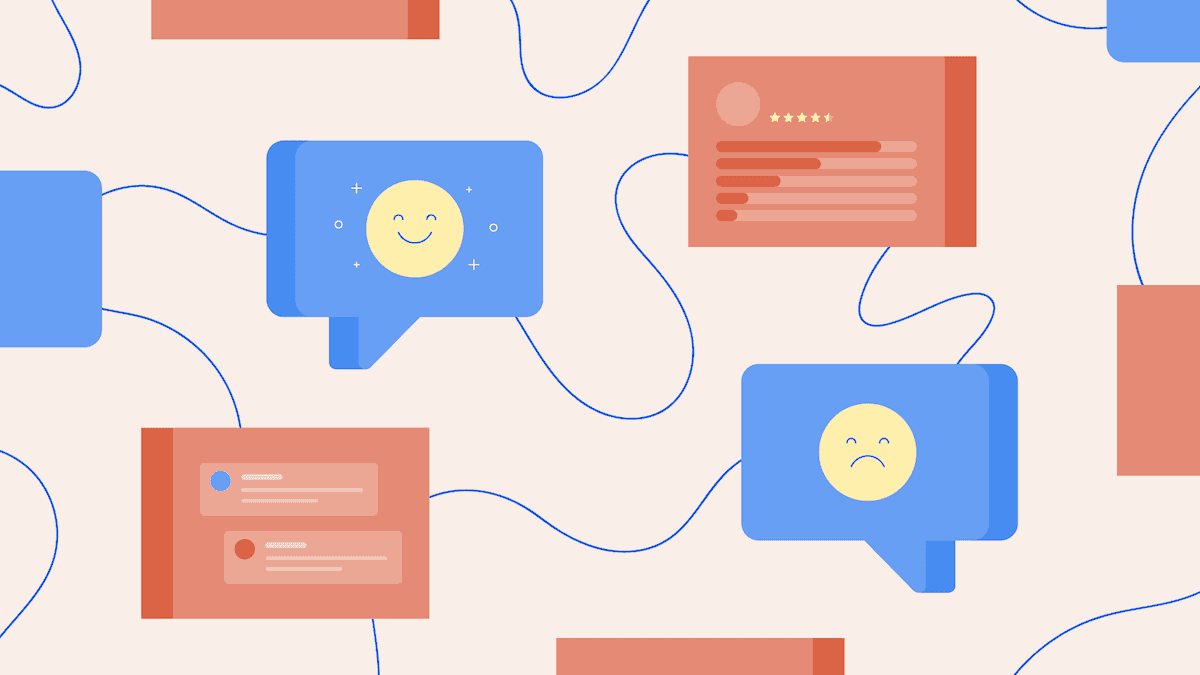
Cloud-based contact centers offer many advantages over on-premises alternatives. They’re flexible, customizable, and more inexpensive — and they let your reps do more with less.
If you want to deliver the best customer experience, this guide has you covered. We’ll dive deeper into what is CCaaS and how it’s different from UCaaS and other software solutions. Then we’ll share our recommendations for what to look for in a CCaaS provider.
What is Contact Center as a Service (CCaaS)?
Contact Center as a Service (CCaaS) is cloud-based software that provides customer communication functions without using traditional call center equipment.
CCaaS solutions streamline every customer touchpoint into a single platform. These interactions include outbound and inbound phone calls, website chats, emails, support tickets, and text messages.
By consolidating customer interactions into a single contact center solution, companies can focus on delivering value at every point along the customer journey.
Some of the most popular features found in CCaaS offerings include:
- Call queueing to increase agent productivity and customer satisfaction
- Interactive Voice Response (IVR) for automatic call routing to the best agent
- Call recording to listen to calls between agents and customers
- App integrations with existing business systems such as CRM and workforce management
- Artificial intelligence to help with forecasting contact volume and optimizing customer support interactions in real-time
Now, let’s look at the critical differences between cloud-based and on-premises contact centers.
Cloud-Based vs. On-Premises Contact Centers
Companies upgrade their call center technology to the cloud as a service for a few reasons.
When compared to an on-premises contact center, a cloud contact center is:
- More cost-effective. Cloud-based contact center solutions let you pay as you go with a monthly or yearly plan, so they don’t require a significant upfront investment. The cost savings continue to rise since there’s also zero maintenance.
- Easier and faster to set up. Deploying an omnichannel contact center in a matter of days — rather than months — is attractive to many businesses. With less hardware, your team focuses on exceeding customer expectations.
- Best for several communication channels. Even though inbound calls are the preferred customer contact method, your support reps can manage requests by email, text, chat, or message you via social media.
- Adaptable to work anywhere. Employees don’t need to be in-office with contact center software to help customers. This flexibility enables call center managers to scale workforce management and continuity planning.
- Connected with integrations. Today’s contact center solutions have built-in API integrations with your existing tools. This functionality means your team can stay in sync no matter what apps they use.
- Scalable and flexible. A cloud-based solution lets you expand your contact center when it’s time. You don’t need to pay upfront for anything you don’t need, nor worry about crazy expensive costs when it’s time for an upgrade.
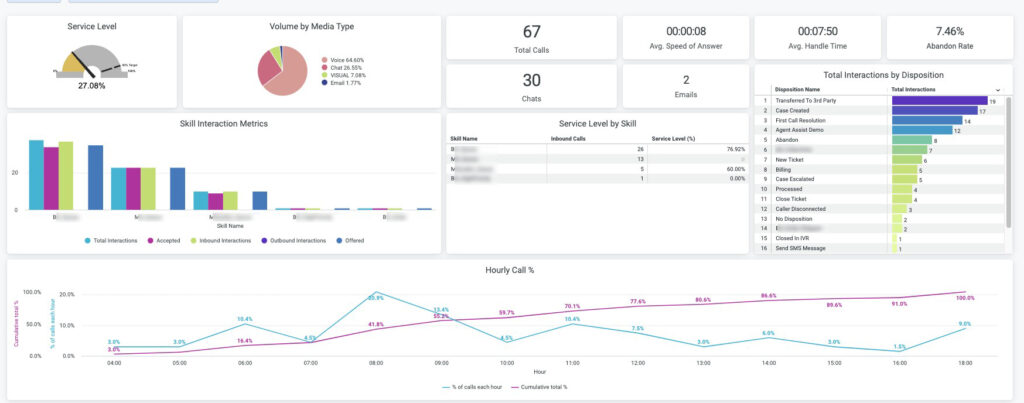
New projections from Gartner forecast contact center revenues will reach $17.9 billion by 2024. The research firm also expects on-premises call center infrastructure will decline.
This outlook suggests that on-premises call center technology still lags behind the market’s demands. Cloud contact centers boast a faster setup, more customer communication features, and better value overall.
What’s the Difference Between a Call Center and a Contact Center?
Contact centers and call centers are often used interchangeably but serve customers using two distinct customer support technologies.
A call center handles voice calls only. Call center software is ideal for outbound and inbound calls, such as sales teams and customer support.
A contact center functions over the phone, email, text message, and social media. Contact centers field customer interactions over several touchpoints. Today’s customers no longer funnel through one channel to reach a business.
Companies primarily serving customers over the phone should turn to a hosted call center. However, if you want to give your customers multiple options for contacting you, a cloud contact center is the better choice.
💡Intro to Contact Centers: Why Is It Used & How Does It Work?
How UCaaS Differs from CCaaS Solutions
UCaaS and CCaaS appear similar but are entirely different business communication technologies. Here are the Cliff Notes:
👉 Unified Communications as a Service (UCaaS)
Unified Communications is a set of communications technologies that provide users with real-time team messaging, video conferencing, and voice calls in one centrally managed platform. UCaaS functionality is found in many business phone systems, including Nextiva.
👉 Contact Center as a Service (CCaaS)
Contact Center as a Service is a customer communications solution that streamlines multiple channels (phone, email, social media, text messages) into one software. It improves the customer experience by letting agents see each interaction along the customer journey.
Similarities between UCaaS and CCaaS
Both UCaaS and CCaaS are:
- Subscription-based: Pay monthly or yearly to access the cloud communication software.
- Cloud-based: You don’t need on-premises equipment. Everything works over an internet connection.
- Built to scale: Access rich features and add or adjust them as your business needs change.
- CRM integrations: UCaaS and CCaaS solutions offer many API integrations with CRM suites such as Salesforce, HubSpot, or Zoho.
Beyond these, both VoIP technologies include specialized features for different use cases.
Differences between UCaaS and CCaaS
- CCaaS is best for call centers, manages customer communications, and is cloud-based, with the provider handling data and infrastructure.
- CCaaS is preferred for customer service and sales teams with a steady volume of inbound or outbound calls, while UCaaS offers extensive collaboration and multimedia features for internal teams.
- UCaaS is ideal for business communication and offers features like team messaging, video conferencing, and workflow automation tools.
- UCaaS offers customer-facing business phone service as well as internal collaboration features.
✨New Guide: How To Leverage UCaaS and CCaaS to Solve Customer Needs
How to Deploy CCaaS
All you need to deploy CCaaS is a reliable internet connection. But there’s a little more to it than that.
Each company has unique needs for addressing customer questions or running outbound sales campaigns. The specific CCaaS implementation ultimately comes down to the desired workflow and automation the business needs.
Here are four steps common with most Contact Center as a Service deployments.
Step 1: Define business requirements.
Get input from business leaders and customer support management to prioritize which contact center software functions you want to set up first. Here are some customer support metrics for inspiration.
Step 2: Perform initial network connectivity checks.
All users must be able to maintain at least 1 Mbps up and down with low latency (less than 70ms) and jitter (less than 10ms). Our VoIP quality test will confirm your performance in just a few minutes.
Step 3: Configure workflow automation.
Since a CCaaS solution is more capable than a traditional on-premises call center, you must authenticate each business app integration. You might need a custom API integration key or account for each one. Then adjust the rules to ensure cases and requests are handled correctly.
Step 4: Onboard and train support agents.
Teach your contact center agents and managers to understand and get a feel for the CCaaS platform. This training should arrive in phases to align with each customer communication channel.
From there, adjust your company’s IVR, automatic call distribution (ACD), and workflows in an online portal. Then let your team use their contact center software across every customer touchpoint.
🧐What Is a Cloud Contact Center & How Does It Work?
Benefits of Contact Center as a Service
Companies adopt cloud-based contact center technology for a handful of reasons. If you’re researching use cases and the advantages of using CCaaS, this will help.
Let’s take a closer look at the top CCaaS benefits.
#1 Deliver a Better Omnichannel Customer Experience
Customers want brands to support them using the channel of their choice when seeking help. The last thing they want to see when they send a message on social media is to submit their request on a contact page.
CCaaS platforms let you help customers regardless of their preferred mode of communication. No matter if they arrive via phone, email, or social media, you’re covered. The customer service team shares a view into every message rather than having messages going unread for days on Facebook.
A study by HubSpot uncovered consumers use 13 separate channels to reach a business. Additionally, the speed of answering their questions predicted customer loyalty and satisfaction.
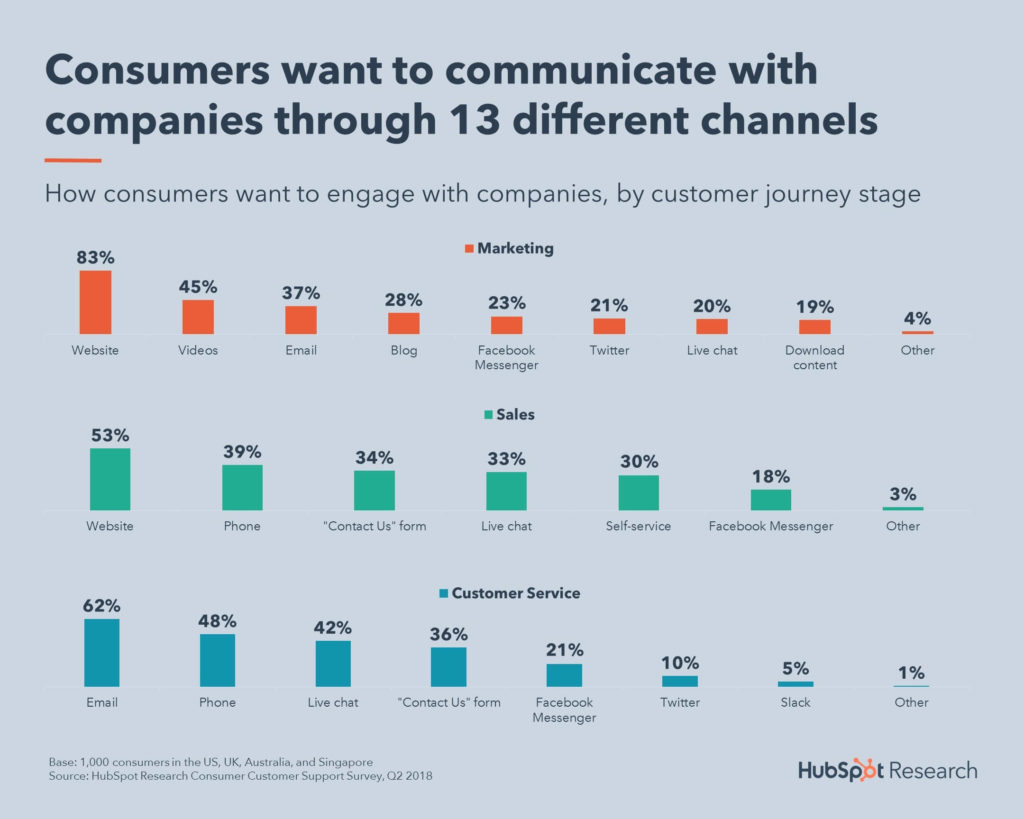
In the age of self-service, a contact center is an excellent way to stand out and provide a human touch to your brand. Advancements in AI, like natural language processing and chatbots, can do some of the heavy lifting when maximizing customer engagement.
#2 Centralize Every Customer Interaction in One Place
Customer support agents can view real-time customer sentiment, account value, and customer satisfaction without wasting time switching between platforms. And since every customer interaction is tracked and stored, there’s no uncertainty when looking up prior information.
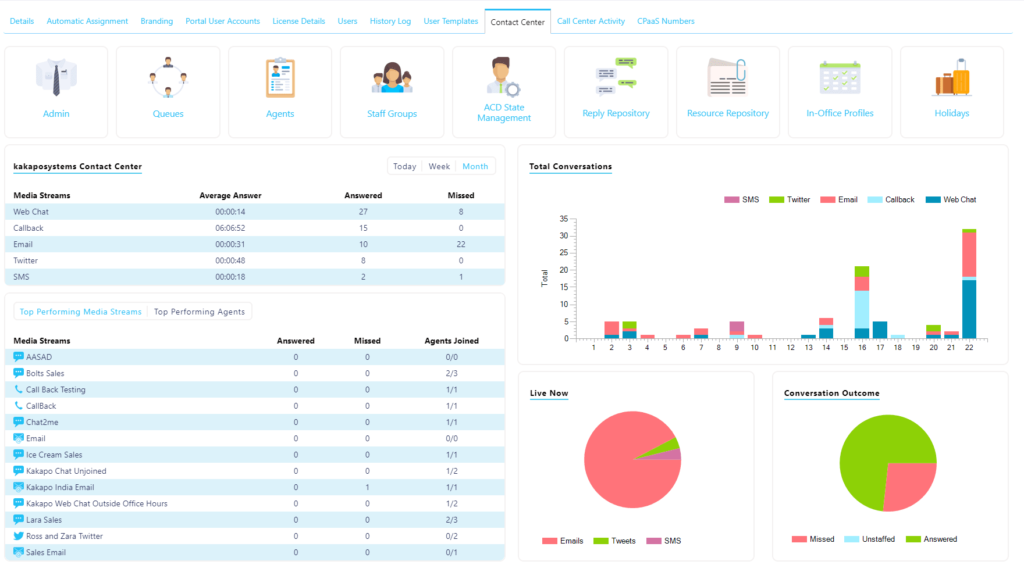
💪 33 Must-Have Call Center Phone System Features
#3 Increase Employee Productivity and Lower Costs
CCaaS isn’t as expensive as you might expect.
Cloud contact center pricing is around $100 per user monthly. This costs less than an on-premises contact center infrastructure, which can easily surpass six figures. Plus, additional licensing and maintenance costs come with non-CCaaS providers.
Among the top benefits of using a Contact Center as a Service is that it doesn’t have proprietary hardware or startup costs that depreciate.
The cost savings don’t stop there. CCaaS solutions let your agents work faster and more efficiently, maximizing labor and technology investments.
#4 Create a More Flexible and Optimized Team
Omnichannel contact center technology directs requests to any desired destination. This benefit means agents can work across multiple time zones and on any device, including phones, laptops, and tablets.
This flexibility is a win-win to reduce employee turnover and give you access to talent in different markets. Your customers will benefit as well from having agents available around the clock.
We can’t ignore the bigger trend, either. Gartner predicts four out of five enterprises will shut down their traditional data centers by 2025.
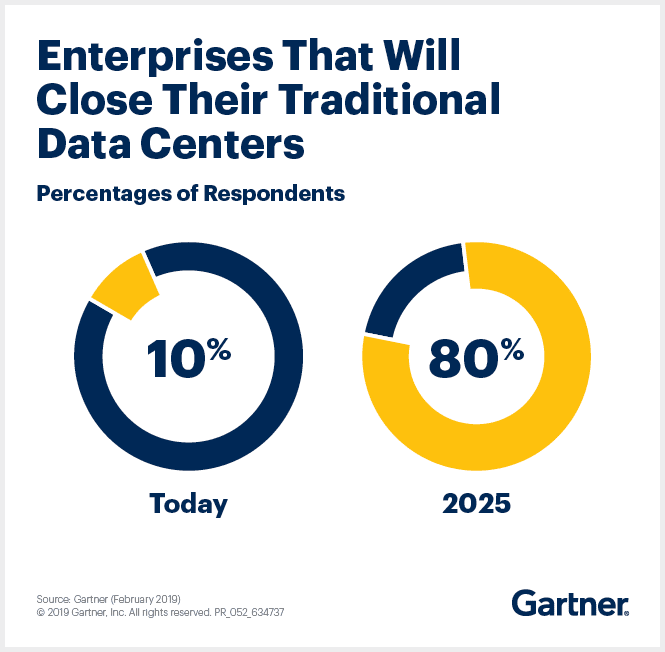
#5 Increase Scalability and Reduce Downtime
If you only have ten customer support agents today, you don’t need to buy 100 seats. The beauty of CCaaS is you can add capacity and functionality whenever you want.
And there are certain things you can’t put a price on, but you can definitely put a price on reliability. Downtime is expensive when clients can’t reach your support team and salespeople can’t close sales. Office moves, severe weather, and equipment failures threaten your best planning.
Cloud-based telephony boasts an uptime of 99.999%, which is enterprise-grade reliability.
As a CCaaS provider, Nextiva has you covered. Its network has eight data centers throughout North America. No matter what happens, your team stays operational. In the event of a loss of connectivity, automatic failover kicks in and adjusts real-time call routing for voice calls.
#6 Stay in the Know With Customer Experience Analytics
Streamlining communication channels through a contact center solution sheds more light on what needs to be improved. Consolidating contact channels helps your team make more informed decisions faster. Spot things like customer interaction analytics, social media sentiment, customer engagement, and more.
On top of that, you can analyze how many interactions it takes to solve customer issues. By optimizing any gaps in your support process, you boost customer retention and customer lifetime value.
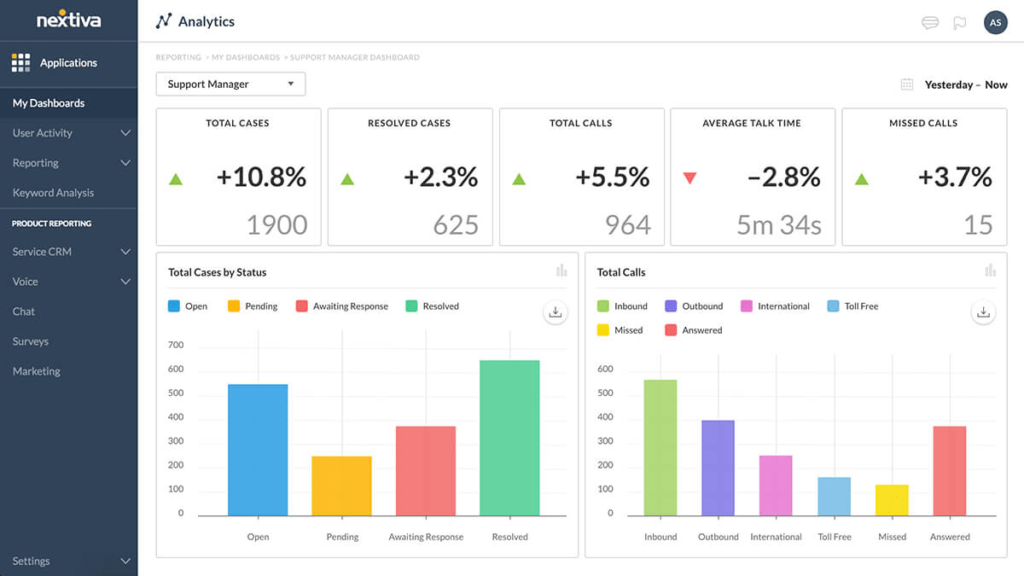
Essential CCaaS Features
When exploring different contact center solutions, remember that you want a platform that helps solve your business needs with the right blend of communication functionality.
The best contact center solution in the market should have the following CCaaS features:
- Chatbots – Automated, live chat interactions from your website.
- Screen pop – A pop-up for contact center agents featuring info about callers or new requests.
- Call recording – Recording calls improves quality management and serves as valuable training for your customer support or sales team reps.
- PCI compliance – CCaaS offers secure methods for people to provide their credit card details to agents.
- Predictive dialer – An outbound call center technology that aims to connect agents immediately after their call.
- CRM integration – An underlying business application that maintains all customer relationship and sales transaction data.
- Speech-enabled IVR – An interactive voice response (IVR) system with verbal commands to interact with inbound calls.
- Quality management – A business process to review customer interactions given a set of standards and customer expectations.
- Workforce management – Strategies and processes for optimizing agent productivity so a contact center can operate efficiently.
- Intelligent virtual agents – A digital assistant with an AI-powered conversation with customers, often taking care of basic tasks or routing their requests to the right team.
- Contact center monitoring – Real-time surveillance of customer conversations with reps. While primarily for voice calls, CCaaS tools also let you see social media or text message responses.
- Natural language processing – A contact center technology that analyzes conversations in real-time for the intended meanings to suggest helpful tips for team members.
- Unified reporting across channels – Aggregates business metrics agnostic from a specific customer touchpoint (like chatbots or phone calls).
- Lowers effort for customer interactions – Decreases the effort required to get help, including consistency across contact channels.
Tips for Choosing the Best CCaaS Platform
Selecting the right contact center software for your business will ensure that your agents can provide customers with top-notch service no matter how they reach you.
A contact center is ideal for consistent customer requests, orders, or help desk tickets since it merges voice, email, text, and social media in one easy-to-use omnichannel solution.
As you explore different providers, here are some essential questions to consider:
- What are your business priorities? It’s easy to get excited about all the features and perks of a new communication platform, but align these with your OKRs.
- How easy is it to add users? You might have 20 contact center agents today, but you might be at 60 by the end of the year. Understanding how easy it is to manage new users before committing to a provider can save you from headaches later.
- Do you need any app integrations? Knowing which integrations you need may be tricky since UCaaS will likely replace some of your existing business apps. Check if your platform offers a built-in email or CRM integration.
- What support options are available to you? Most contact center providers charge extra for live technical support and onboarding. Make sure to research how easy it is to contact each provider.
- What kind of training or learning resources will you need? Not all UCaaS or CCaaS solutions are simple, so take the time to learn how easy it is to get started.
- Which industry-specific features do you need? Think about specific business processes and legal obligations your company has today or may have in the future. For example, you may be bound to HIPAA, PCI, or other recordkeeping requirements. Make sure the providers you’re looking at can accommodate any industry-specific requirements.
Related: 12 Steps To Move Your Phone System to the Cloud [Checklist]
And with that, you’re ready to confidently select your next Contact Center as a Service provider.
If you want to equip your sales and support teams, CCaaS is the perfect, scalable solution. For almost every other department, UCaaS is a wise choice. You get the most communication features that most employees need.
Find the solution that lets you work efficiently and provide a better customer experience. With the right business phone system, you won’t need to settle for one or the other.
Contact Center as a Service (CCaaS) is cloud-based software that provides customer communication functionality without using traditional call center equipment.
CCaaS solutions streamline every customer touchpoint into a single platform. These interactions include outbound and inbound phone calls, website chats, emails, support tickets, and text messages.
Contact centers and call centers are often used interchangeably but serve customers using two distinct customer support technologies.
A call center handles voice calls only. Call center software is ideal for outbound and inbound calls, such as sales teams and customer support.
A contact center functions over the phone, email, text message, and social media. Contact centers field customer interactions over several touchpoints. Today’s customers no longer funnel through one channel to reach a business.



.png#keepProtocol)



.png#keepProtocol)
More Stories
Level Up Your Career With These 7 Professional Development Tips
Donald Trump Gets a Solution to His Cash Problem
Crypto Exchange Gemini To Refund $1.1B To Earn Program Customers